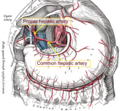Hepatic artery proper
Hepatic Artery Proper
The Hepatic Artery Proper is a short blood vessel that supplies oxygenated blood to the liver, pylorus of the stomach, and the duodenum. It arises from the Common Hepatic Artery, a branch of the Celiac Trunk.
Anatomy[edit]
The Hepatic Artery Proper usually gives off the Right Gastric Artery and then continues as the Common Hepatic Artery. It then divides into the Right Hepatic Artery and Left Hepatic Artery which supply blood to the corresponding lobes of the liver.
Function[edit]
The Hepatic Artery Proper carries oxygenated blood from the heart to the liver. This blood is rich in nutrients and oxygen, which are necessary for the liver to perform its functions.
Clinical Significance[edit]
The Hepatic Artery Proper can be involved in several medical conditions. For instance, it can be affected by Hepatic Artery Thrombosis, a condition where a blood clot forms in the hepatic artery, blocking blood flow to the liver. This can lead to liver damage and is a serious medical emergency.
See Also[edit]
- Liver
- Hepatic Artery
- Common Hepatic Artery
- Celiac Trunk
- Right Gastric Artery
- Right Hepatic Artery
- Left Hepatic Artery
- Hepatic Artery Thrombosis
References[edit]
<references />
|
|
|
Hepatic_artery_proper[edit]
-
Common and proper hepatic artery
-
Gray's Anatomy illustration of the liver
-
Gallbladder and hepatic artery
-
Gray's Anatomy illustration of the hepatic artery
-
Gray's Anatomy illustration of the liver and gallbladder
-
Slide showing common hepatic artery
Ad. Transform your life with W8MD's Budget GLP-1 injections from $75


W8MD offers a medical weight loss program to lose weight in Philadelphia. Our physician-supervised medical weight loss provides:
- Weight loss injections in NYC (generic and brand names):
- Zepbound / Mounjaro, Wegovy / Ozempic, Saxenda
- Most insurances accepted or discounted self-pay rates. We will obtain insurance prior authorizations if needed.
- Generic GLP1 weight loss injections from $75 for the starting dose.
- Also offer prescription weight loss medications including Phentermine, Qsymia, Diethylpropion, Contrave etc.
NYC weight loss doctor appointmentsNYC weight loss doctor appointments
Start your NYC weight loss journey today at our NYC medical weight loss and Philadelphia medical weight loss clinics.
- Call 718-946-5500 to lose weight in NYC or for medical weight loss in Philadelphia 215-676-2334.
- Tags:NYC medical weight loss, Philadelphia lose weight Zepbound NYC, Budget GLP1 weight loss injections, Wegovy Philadelphia, Wegovy NYC, Philadelphia medical weight loss, Brookly weight loss and Wegovy NYC
|
WikiMD's Wellness Encyclopedia |
| Let Food Be Thy Medicine Medicine Thy Food - Hippocrates |
Medical Disclaimer: WikiMD is not a substitute for professional medical advice. The information on WikiMD is provided as an information resource only, may be incorrect, outdated or misleading, and is not to be used or relied on for any diagnostic or treatment purposes. Please consult your health care provider before making any healthcare decisions or for guidance about a specific medical condition. WikiMD expressly disclaims responsibility, and shall have no liability, for any damages, loss, injury, or liability whatsoever suffered as a result of your reliance on the information contained in this site. By visiting this site you agree to the foregoing terms and conditions, which may from time to time be changed or supplemented by WikiMD. If you do not agree to the foregoing terms and conditions, you should not enter or use this site. See full disclaimer.
Credits:Most images are courtesy of Wikimedia commons, and templates, categories Wikipedia, licensed under CC BY SA or similar.
Translate this page: - East Asian
中文,
日本,
한국어,
South Asian
हिन्दी,
தமிழ்,
తెలుగు,
Urdu,
ಕನ್ನಡ,
Southeast Asian
Indonesian,
Vietnamese,
Thai,
မြန်မာဘာသာ,
বাংলা
European
español,
Deutsch,
français,
Greek,
português do Brasil,
polski,
română,
русский,
Nederlands,
norsk,
svenska,
suomi,
Italian
Middle Eastern & African
عربى,
Turkish,
Persian,
Hebrew,
Afrikaans,
isiZulu,
Kiswahili,
Other
Bulgarian,
Hungarian,
Czech,
Swedish,
മലയാളം,
मराठी,
ਪੰਜਾਬੀ,
ગુજરાતી,
Portuguese,
Ukrainian








